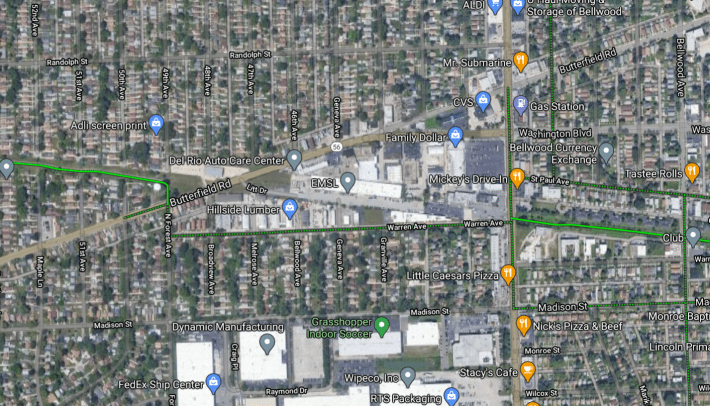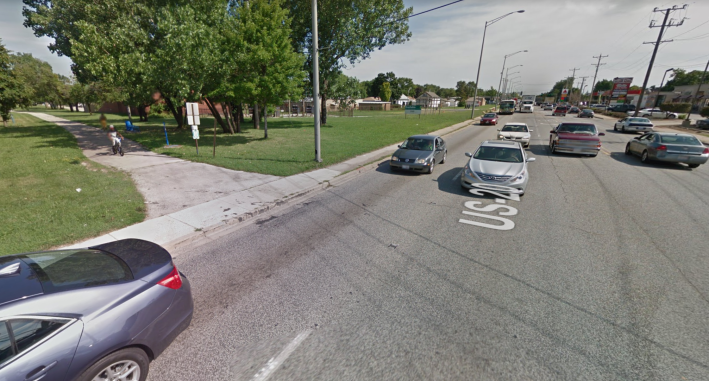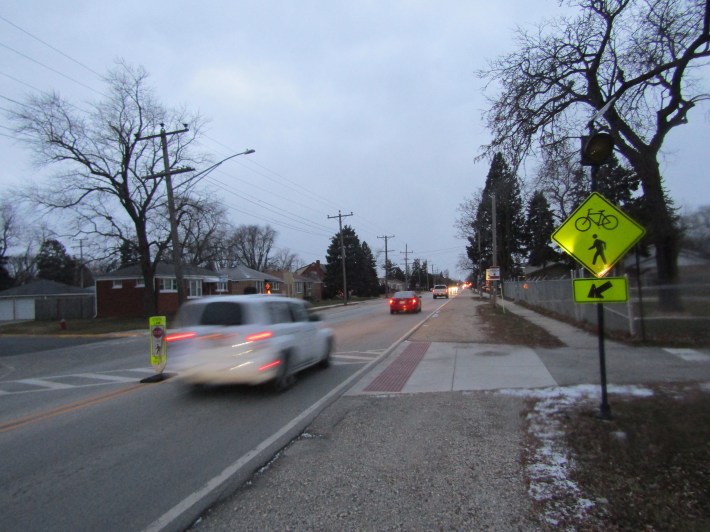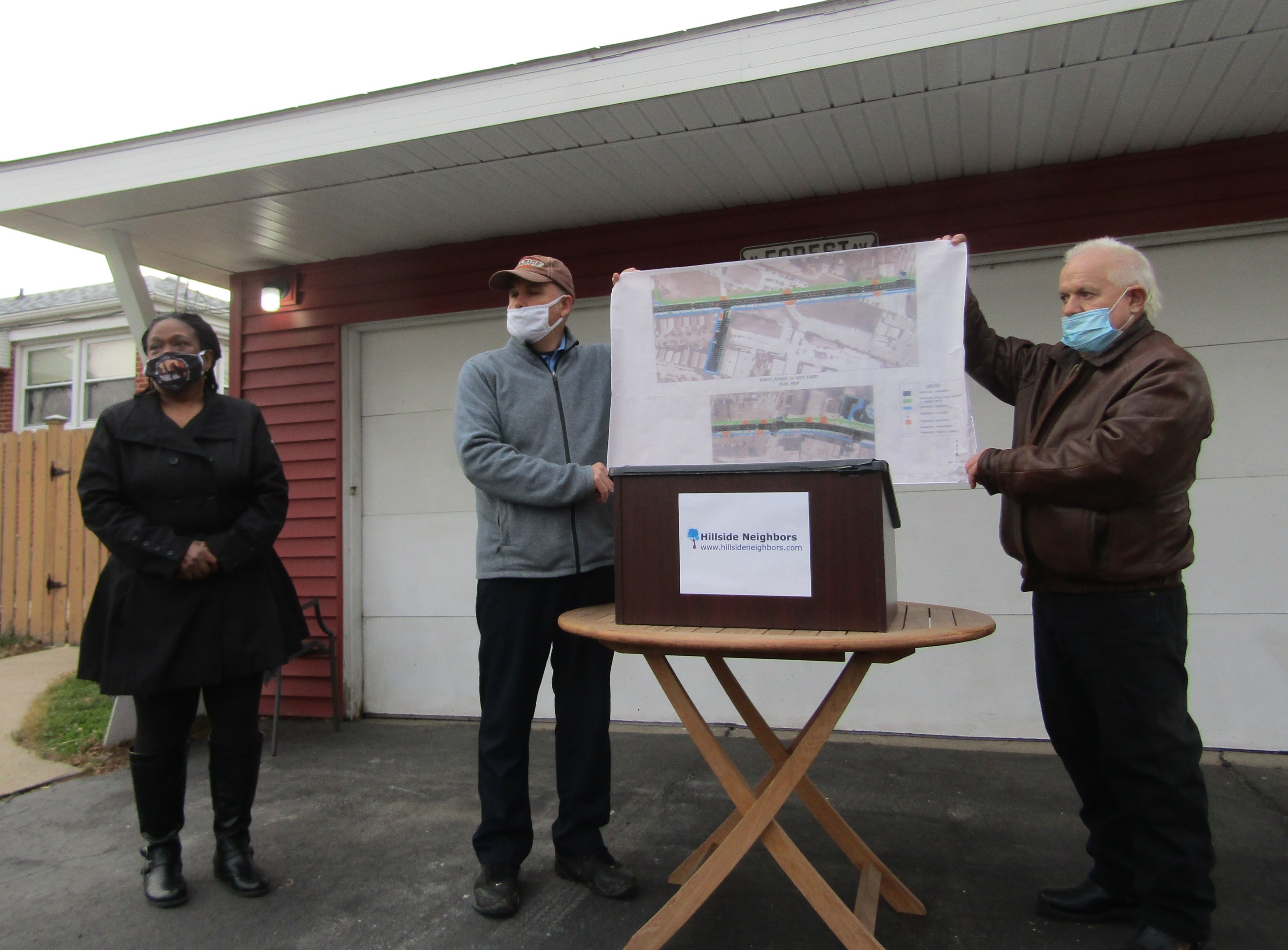Political hopefuls in west-suburban Hillside have turned the Illinois Department of Transportation's plans for the Illinois Prairie Path into an election issue. The fight against the improvements are being led by a figure who is well-known to longtime Streetsblog Chicago readers, Ashland bus rapid transit opponent Roger Romanelli.
As the state’s first rails-to-trails, the Illinois Prairie Path mostly follows its own dedicated right of way. But in Hillside, it diverts onto Forest and Warren avenues between Butterfield and Mannheim roads. Not only are there no bike lanes on this stretch, there are no traffic signals for the two major street crossings at either end of that segment.
In 2018, the Village of Hillside received a $2 million state grant to relocate this section of the Prairie Path by creating bike lanes on the north side Butterfield Road and Washington Boulevard, as well as to build a pedestrian bridge over the Eisenhower Expressway at Mannheim (which is unrelated to the path project.) With the trail relocation, cyclists and pedestrians would only have to cross one busy street instead of two, at Washington/Mannheim, a location that already has a traffic signal.
Hillside Neighbors, a slate of candidates, including Romanelli, running against the incumbent mayor, village clerk and three village trustees in the April 6, 2021 election, has denounced the trail relocation project as a waste of money. They argue that it would make more sense retain the current route on Forest and Warren and install a traffic signal at Butterfield/Forest.
Hillside village manager Russ Wajda told me that the trail relocation was something IDOT insisted on in order to green-light repaving Butterfield Road, which he said is the village's main priority. He added that the project is in limbo until Hillside actually receives the funds, which he doesn’t expect to happen any time soon.
IDOT declined to comment. But with the election coming up in three months, Hillside Neighbors has been using the project to attack their opponents, calling it one of the examples of wasteful spending they would put an end to if elected.
Illinois Prairie Path history and right-of-way
The Illinois Prairie Path was converted from the Chicago Aurora and Elgin Railroad interurban train line. At its peak, the line ran between downtown Chicago and west suburban Wheaton, where it split off into multiple branches continuing toward Elgin, Aurora,Batavia and St. Charles. It used the Garfield Park ‘L’ Line tracks to reach the Loop.
In the 1950s, the Garfield Line was demolished to make way for the Eisenhower Expressway and replaced by what is now the Blue Line. The interurban was cut back to Forest Park. While by that point the railroad was already struggling in the face of highway expansion, losing direct access to the Loop didn't help. Passenger service ended in 1957, and the line was officially abandoned altogether in 1961. Most of the right-of-way survived intact and, over the next two decades, it was converted into the trail that largely follows that corridor.
Looking at the Google Maps satellite view, one can easily see where the interurban used to run in a straight line between Butterfield and Mannheim. But that right of way got turned into parking lots of the surrounding businesses, and the parking lot closest to Mannheim is fenced off.

Since that section of the old rail right-of-way is impassible, the official trail map directs users to instead use Forest and Warren avenues to connect between Butterfield and Mannheim. At Warren/Manheim, the map tells the users to walk their bikes on the sidewalks of Mannheim to traffic signals a block north cross at Washington Boulevard or a block south at Madison Street. But many trail users don't bother to do that and simply take the more direct approach of crossing Mannheim, a busy four-lane state highway, at Warren.

At Forest, Butterfield is a two-lane road with a clearly-marked crosswalk, and there are yellow caution signs with flashing lights to warn drivers to watch out for bicyclists and pedestrians crossing the road. The Warren/Mannheim only has bicycle crossing signs, but no marked crosswalk.
As the alternative to the current bike route on Forest and Warren, IDOT wants to install bike lanes on the north side of Butterfield and Washington between Forest and Mannheim. As it stands, many portions of that stretch don’t even have sidewalks.
The local political struggle
Joseph Tamburino has been Hillside mayor since 1981. According to the Cook County Clerk’s election result records, he hasn’t faced any opposition since at least 2001 (the furthest back the online records go), and his Hillside Independent Party slate went into several of those elections unopposed.
The Hillside Neighbors slate stands out because it’s the only slate in the past 20 years to have candidates for all offices. It was organized by Roger Romanelli, head of Chicago's Fulton Market Association, who organized a misleading Not In My Back Yard-style opposition campaign that helped kill the city of Chicago's plan for bus rapid transit on Ashland Avenue. Romanelli grew up in Hillside and moved back to the village a few years ago.

In Hillside, he founded the Hillside Forward organization, which he says wants lower taxes, better services, more community development and improvements to the Prairie Path. While Hillside Neighbors is a separate organization on paper, its candidates are all Hillside Forward members, and they are all fairly upfront about the connection between the two groups. Romanelli, Dan Adams, and Amy Woodrick are running for the three trustee seats. The slate also includes mayoral candidate Gwendolyn Amber and village clerk candidate LaTonya Williams.
As part of their platform, Hillside Neighbors have been speaking against IDOT's plan for the path relocation and the pedestrian bridge. A November 21 press conference they held focused on denouncing the projects. The presser was held in from of Romanelli’s home, located on Forest, a block south of Warren.
Romanelli argued that the Prairie Path is fine as it is, describing the relocation as “a completely unnecessary proposal. Here in [this] neighborhood, we want the Prairie Path to stay on Warren Avenue. All of us as neighbors want to keep bicycles on Warren Avenue for the vitality and safety of our village.”
Instead, he said, the village should put in the traffic signal at the Butterfield Road crossing and add bike lanes on Warren. Romanelli argued that it would save the state money during the pandemic budget crunch, and that would allow the village to redirect funds to another plank of Hillside Neighbors’ platform, hiring social workers to assist the police when they’re out in the field.
However, it's unlikely that installing a new stoplight actually would be significantly cheaper, if at all, than IDOT's plan to stripe a half-mile of bike lanes on Butterfield and Washington. And even if that was the case, it's unclear whether the same funding that would be otherwise used for infrastructure could be used to pay social workers.
Adams described himself as an “avid bicycle rider” who enjoys using the trail. He argued that the path's current crossing of two-lane Butterfield isn’t safe. “I see people waiting at the little yellow light that they have and the [drivers], they don’t even pay attention. It’s a danger, it’s a real danger.”
He added that he is “deeply offended that Tamburino and the [village] officials want to reallocate the Prairie Path. Where the path is today is safe, affordable and perfect. That’s what our neighbors want. We can make today’s path safe, and we prevent our taxes from going through the roof, and safeguard our Hillside families.”
But, again, village manager Wadja said that relocating Prairie Path wasn’t Hillside’s idea. The village wanted to repave Butterfield between Mannheim and Wolf roads. Since it’s a state highway, Hillside had to coordinate its plans with IDOT. While IDOT was willing to reimburse the village for 80 percent of the costs, it had conditions.
“When we turned in our initial engineering overview drawings, IDOT said, 'We don't want a Prairie Path crossing [of Butterfield] at Forest Ave, we don't think it's safe, we want you to move the path onto the north side of Butterfield Road, take the pedestrians and bicyclists to Mannheim and have them cross at a signalized intersection,'” Wadja said.

And while Hillside was supposed to get the grant in 2018, Wadja said that IDOT never came through with the money. “Right now, [the project is at] a standstill until the state comes up with the funding.”
IDOT spokesperson Maria Castaneda said that the Prairie Path relocation was “a local roads project that is being managed by the local municipality,” so she advised me to direct all questions to Hillside.
It’s not clear how most Hillside residents feel about the issue. But during the November 23 Hillside village board meeting, resident Janet Dubsky argued that Hillside Neighbors’ safety concerns were overblown, and that cyclists can safely use what’s already there. “As far as putting in a streetlight at Butterfield and Forest, in my opinion, that’s not needed – patience is needed."




